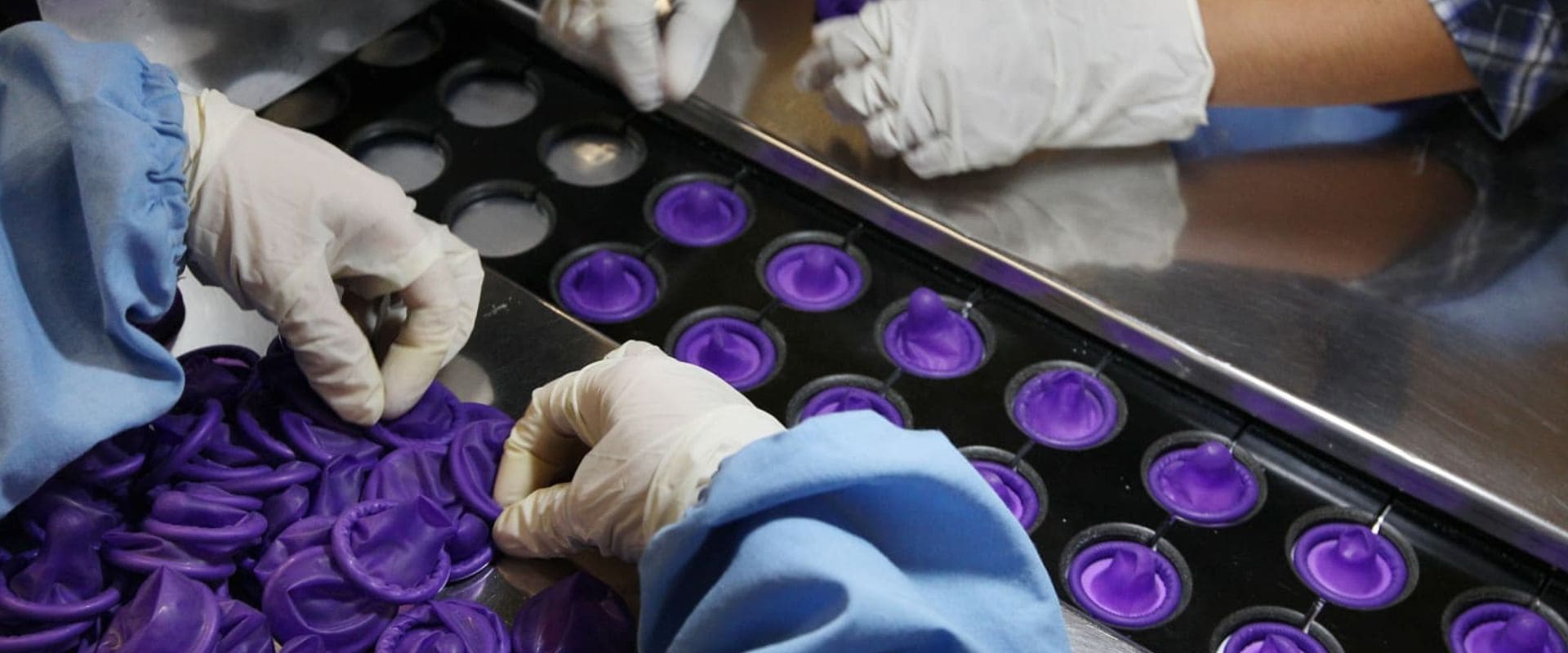Abstract
Ensuring safety & quality: Control condoms meet stringent standards, prioritizing user protection
Blog
The condom then takes shape in the dipping stage, where a glass mold is dipped into temperature-controlled latex tubs, then re-emerged and rotated to ensure even distribution of the material. Once dry, the condoms are washed again and the testing phase begins.
Testing Phase:
- High Voltage Electric Field: All condoms are tested to identify holes or uneven thickness.
- Quality Control Metrics: Samples are taken for length, width, and thickness measurements.
- Leak Testing: Samples are filled with water to detect micro-holes.
- Strength Testing: Volume and burst pressure measurements assess condom durability.
- Artificial Aging: Condoms undergo accelerated aging tests to verify stability.
The leak testing process during the testing phase of condom production involves assessing the integrity of the condoms by checking for the presence of micro-holes. These micro-holes, if present, could potentially compromise the effectiveness of the condom in preventing unwanted pregnancies and sexually transmitted infections.
To conduct the leak testing, samples of the manufactured condoms are taken and filled with water at room temperature. This step is crucial as it simulates real-world conditions where condoms may come into contact with bodily fluids during use. The condoms are carefully inspected while filled with water to detect any signs of liquid leakage.
If there are no micro-holes or defects present, the condom will effectively hold the water without leaking. However, if there are any micro-hole’s present in the condom material, water will seep through, indicating a potential breach in the condom’s integrity.
This leak testing process is essential for ensuring the quality and reliability of the condoms before they are packaged and distributed to consumers. By identifying and eliminating defective condoms during the testing phase, manufacturers can uphold the highest standards of product safety and effectiveness.
Additionally, this meticulous testing process helps to instill confidence in consumers regarding the quality and reliability of the condoms they use. It provides assurance that the condoms have undergone rigorous quality control measures to ensure they meet regulatory standards and offer maximum protection during use...
Resistance Testing: One aspect of quality assurance involves testing the resistance of the condoms. This includes assessing their ability to withstand stretching and pressure without tearing or breaking. Control condoms undergo rigorous testing to ensure they exceed regulatory requirements in terms of resistance. By surpassing these standards, the condoms are better equipped to withstand the stresses encountered during sexual activity, reducing the risk of failure and providing greater reassurance to users.
Volume and Pressure Testing: Quality assurance also involves evaluating the volume and pressure capacity of the condoms. This includes measuring the volume of air or liquid the condom can hold without bursting under pressure. Control condoms undergo testing to determine their volume and pressure thresholds, with the aim of surpassing regulatory requirements. By exceeding these benchmarks, the condoms demonstrate their robustness and reliability in real-world use scenarios, offering users greater confidence in their effectiveness.
Compliance with Regulatory Standards: Quality assurance extends to ensuring that Control condoms comply with all relevant regulatory standards and guidelines. This involves adhering to strict manufacturing protocols, using high-quality materials, and conducting thorough testing at various stages of production. By meeting or exceeding regulatory requirements, Control condoms demonstrate their commitment to safety, quality, and consumer satisfaction.
Continuous Improvement: Quality assurance is an ongoing process that involves continuous monitoring, evaluation, and improvement. Control condoms are subject to regular quality control checks and feedback loops to identify areas for enhancement. This iterative approach helps to drive innovation, optimize manufacturing processes, and maintain the highest standards of product quality and performance.
Consumer Confidence: Ultimately, quality assurance measures are designed to instill confidence in consumers regarding the safety and reliability of Control condoms. By exceeding regulatory requirements and implementing robust quality control measures, Control demonstrates its commitment to product excellence and user satisfaction. This not only enhances the brand’s reputation but also promotes safer sexual practices and contributes to public health outcomes.



